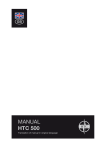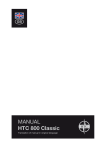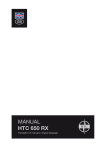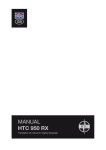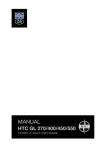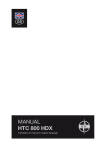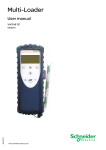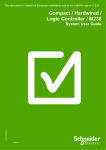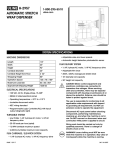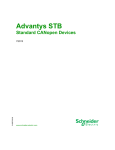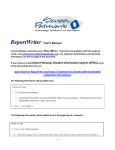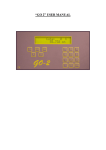Download Contact Information
Transcript
GB MANUAL HTC 420 VS Translation of manual in original language Contact Information HTC Sweden AB Box 69 SE-614 22 Söderköping - Sweden Tel: +46 (0) 121-294 00 Fax: +46 (0) 121-152 12 You can find addresses for our retailers and service partners on our website: www.htc-floorsystems.com Always specify the model and serial number when asking questions about your product. Trademarks HTC is a trademark owned by HTC Sweden AB. Other names and products mentioned in this manual may be registered trademarks owned by the relevant companies. © 2007 HTC Sweden AB. All rights reserved. EC Declaration of conformity Manufacturer: HTC Sweden AB Box 69 SE-614 22 Söderköping Sweden +46 (0)121-29400 Type of equipment: Grinding machine Make: HTC Model: HTC 420 VS Year of manufacture: See machine name plate Serial number: See machine name plate As the manufacturer, we hereby declare under our sole responsibility that the above product with serial numbers from 2004 onward conforms to the applicable regulations in directives MD 2006/42/EC, EMC 2004/108/EC and LVD 2006/95/EC. The following standards have been used as a basis: ISO 5349-1:2001, ISO 5349-2:2001, ISO 20643:2005, ISO 3741. This product was CE-marked in 2004. The technical documentation is available from the manufacturer. Original of the EC declaration of conformity (Swedish). Other languages are translations of the original of the EC declaration of conformity. Söderköping, 01-01-2010 Peter Lundgren Development Manager, HTC Sweden AB Kåre Kilgren Product Manager, HTC Sweden AB HTC 420 VS 1 2 3 4 Table of contents Introduction 1 1.1 General ............................................................................ 1.2 Responsibility .................................................................. 1.3 Manual ............................................................................. 1.3.1 Safety instructions – Explanation of symbols ..... 1.4 Transportation ................................................................. 1.5 On delivery ...................................................................... 1.6 Unpacking the machine ................................................... 1.7 Machine name plate ........................................................ 1.8 Handling and storage ...................................................... 1.9 Vibration and noise .......................................................... 1.9.1 Hand and arm vibrations .................................... 1.9.2 Sound pressure level .......................................... 1 1 1 1 2 2 2 3 3 4 4 4 Safety 5 2.1 General Information ......................................................... 2.2 Warnings ......................................................................... 2.3 Notes ............................................................................... 5 5 6 Machine description 8 3.1 General machine description ........................................... 3.2 Description of controls – Control panel ........................... 8 9 Usage 11 4.1 4.2 4.3 4.4 11 11 12 13 14 15 15 16 17 17 17 17 18 18 4.5 4.6 4.7 4.8 General Information ......................................................... Handle settings ................................................................ Access to grinding tools .................................................. Fitting and replacing grinding tools .................................. 4.4.1 Fitting grinding tools ........................................... 4.4.2 Changing grinding tools ...................................... Preparations for dry grinding ........................................... Preparations for wet grinding .......................................... Operation ......................................................................... 4.7.1 Standby .............................................................. 4.7.2 Emergency stop switch ...................................... 4.7.3 Starting the machine .......................................... 4.7.4 Overload ............................................................. Making operation easier .................................................. i Table of contents 5 6 HTC 420 VS Maintenance and repairs 19 5.1 5.2 5.3 5.4 5.5 5.6 5.7 19 19 19 19 20 20 20 General Information ......................................................... Cleaning .......................................................................... Daily ................................................................................ Every week ...................................................................... Every month (or 100 hours) ............................................. Repairs ............................................................................ Spare parts ...................................................................... Faultfinding 21 6.1 General Information ......................................................... 6.1.1 The machine will not start ................................... 6.1.2 The machine vibrates or wears the tool unevenly ............................................................. 6.1.3 The machine is grinding at an angle .................. 6.1.4 The machine stops immediately after starting .... 6.1.5 The fuses trip frequently ..................................... 6.1.6 The machine cannot cope .................................. 21 21 Electronic error codes 23 7.1 General Information ......................................................... 7.2 Schneider Electric ATV31 ................................................ 7.2.1 Resetting the frequency converter ..................... 7.2.2 Checking the last error code .............................. 7.3 Schneider Electric ATV12 ................................................ 7.3.1 Resetting the frequency converter ..................... 7.3.2 Checking the last error code .............................. 7.4 Schneider Electric ATV312 .............................................. 23 23 25 25 25 26 26 27 8 Technical data 28 9 Environment 30 7 10 Warranty and CE marking 21 21 21 22 22 31 10.1 Warranty .......................................................................... 31 10.2 CE marking ...................................................................... 31 ii HTC 420 VS Introduction 1 Introduction 1.1 General HTC 420 VS is a grinder that can be used to grind, strip, clean and polish concrete, natural stone and terrazzo floors. The machine's area of application depends on the choice of tool. Read the manual carefully, so you are totally familiar with the machine before you start to use it. Contact your local retailer for further information. For contact information, see Contact Information at the start of the manual. 1.2 Responsibility Even though every effort has been made to make this manual as complete and accurate as possible, we bear no responsibility for incorrect or missing information. HTC reserves the right to change descriptions in this manual without giving prior notice. This manual is protected by the Copyright Act and no part of it may be copied or used in any other way without the written approval of HTC. 1.3 Manual In addition to the general functions, this manual deals with the areas of application and the maintenance of the grinder. 1.3.1 Safety instructions – Explanation of symbols A number of symbols are used in the manual to highlight the most important sections, see below. In order to avoid both personal injury and material damage as far as possible, it is extremely important to read and understand the text next to these symbols particularly carefully. There are other symbols indicating practical tips. These are to help you use the machine in the easiest and most effective way. The following symbols are used in the document to indicate where special attention is needed. Warning! This symbol means Warning! and indicates that incorrect use can result in material damage to the machine or accessories. If you see this symbol next to a section of text, you must be particularly careful when reading through the text and not carry out any stages of which you are unsure. This is to protect you and other users and to avoid damaging the machine or other equipment. 3.0 1 Introduction HTC 420 VS Note! This symbol means Note! and indicates that material damage can occur if the machine or its accessories are used incorrectly. If you see this symbol next to a section of text, you must be particularly careful when reading through the text and not carry out any stages of which you are unsure. This is to avoid damage to the machine or other equipment. Tip! This symbol means Tip! and indicates that you can get tips and advice on ways to make operating your machine or associated equipment easier, and to avoid wear. When you see this symbol you should read the accompanying text to facilitate your work and increase the service life of the machine. 1.4 Transportation The machine is best transported securely fastened to a pallet. 1.5 On delivery The following items are included in the delivery. Contact you retailer if anything is missing. 1.6 • Grinding machine • Manual • Locking key for control cabinet • Hammer EZ system • Splash guard • Electrical cable with contact • EZ tool holder • Upper belt (spare part) Unpacking the machine Warning! Read through the safety instructions and the manual carefully before use. 2 3.0 HTC 420 VS • • 1.7 Introduction Check carefully to see if the packaging or machine has been damaged during delivery. If there is any sign of damage, contact your retailer and report it. Report packaging damage to the transport company as well. Check that the delivery matches the order. If there are any discrepancies, contact your retailer. Machine name plate The machine name plate provides the following information. The model and serial number must be specified when ordering spare parts for the machine. Figure 1-1. Machine name plate 1.8 1. Model 2. Model number 3. Serial number 4. Year of manufacture 5. Power (kW) 6. Voltage (V) 7. Current (A) 8. Frequency (Hz) 9. Rotational speed (r.p.m.) 10. Weight (kg) 11. Address field Handling and storage The machine should be stored in a dry, warm location when not in use. Otherwise it may become damaged by condensation and coldness. 3.0 3 Introduction 1.9 HTC 420 VS Vibration and noise Warning! Always use ear muffs when using the machine. 1.9.1 Hand and arm vibrations Hand and arm weighted vibration level [m/s²] for HTC 420 VS have been measured with equipment approved according to ISO 5349-1:2001. The measurement uncertainty for the measurement apparatus has been measured as +/- 2%. The machine has been tested in accordance with ISO 5349-2:2001 and ISO 20643:2005 in order to identify the operations that contribute to the most frequent vibration exposures. At vibration levels > 2.5 m/s², the exposure time should be limited in accordance with the table below. For vibration levels > 5 m/s², immediate measures should be taken by the employer to ensure that the exposure time does not exceed the time specified in the table below. Identified work conditions Measured values [m/s²] Daily permitted exposure (number of hours) 1.9.2 Grinding/polishing 3,08 21,1 Floor preparation (T-rex) 4,76 8,84 Sound pressure level This machine has been tested for noise in accordance with ISO 3741. For information on sound pressure levels, see the table in chapter Technical data, page 28. 4 3.0 HTC 420 VS Safety 2 Safety 2.1 General Information This chapter contains all the warnings and notes that should be considered for HTC 420 VS . 2.2 Warnings Warning! The machine may only be used or repaired by personnel who have received the requisite theoretical and practical training and who have read the user manual. Warning! Never use the machine in an environment with a risk of explosion or fire. Familiarise yourself with the fire-protection instructions for the working area and follow them. Warning! Secure the area around the working area. No unauthorised persons should be allowed within a 15-metre radius of the machine. If a loose object were to catch under the grinding head, this could be flung out and cause personal injury. Warning! Use protective equipment such as safety shoes, safety goggles, protective gloves, breathing mask and ear muffs. Warning! The machine must only be started with the grinding head down. The rotating disc must be touching the floor and the correct tool must be fitted. Warning! Read through the safety instructions and the manual carefully before use. Warning! Always use ear muffs when using the machine. Warning! During grinding, the tools become very hot. Tip the machine back and allow it to stand for a short while. Use protective gloves when removing the tools. Warning! Disconnect the electrical supply, when changing tools or repairing the machine. 3.0 5 Safety HTC 420 VS Warning! The machine must only be used and moved on level surfaces. There is a risk of crushing if the machine starts to roll. Warning! Connect the machine to an earth fault breaker. Warning! Do not clean the machine using a high-pressure washer. Otherwise moisture may penetrate electrical elements and damage the machine’s drive system. Warning! The machine may only be used when the splash guard is fitted. 2.3 Notes Note! The machine may only be used to grind and polish natural stone, terrazzo, concrete, or other materials stated in this manual or that are approved by HTC. Note! Only original tools and spare parts from HTC may be used for the machine. Otherwise neither the CE marking nor the warranty will be valid. Note! For the CE marking to be valid, the instructions in this manual must be followed. Note! The machine must only be lifted using the lifting eye intended for the purpose in accordance with the relevant instructions. Note! The machine should be stored in a dry, warm (plus degrees) location when not in use. Note! If the machine is stored in a cold (minus degrees) location, it must be placed in a warm (plus degrees) location for at least two hours before use. 6 3.0 HTC 420 VS Safety Note! The appropriated dust extractor must be used when dry grinding. Contact HTC for model recommendation. Note! The dust extractor's suction hose must be connected to the appropriate socket on the machine. Adjust the dust extractor to match the grinder's capacity. Note! Do not use the emergency stop switch to stop the machine, except in emergencies. Note! As long as the emergency stop switch is pressed in, the machine cannot be started. Reset by turning the switch 45° clockwise so that it pops out again. The machine can then be restarted. Note! After removing glue and wet grinding, always lift up the grinding heads so that they do not stick to the floor and damage machine components and the floor when restarting. Note! When wet grinding, the water tank must be filled with water. Only use cold water with no chemical additives. 3.0 7 Machine description HTC 420 VS 3 Machine description 3.1 General machine description The machine is constructed from a number of main components, see Figure 3-1, page 8 and Figure 3-2, page 9. There are three motor alternatives: 230 V 1-phase (EU), 400 V 3-phase (EU) and 115 V 1-phase (US). The machine is based on a wheeled chassis. The motor with a rotating grinding unit is attached to the bottom of the chassis, so that there is some movement between the chassis and motor package. The handle can be set at several different angles. Set the handle at the position that suits you best. The grinding cover has a connection for two external suction hoses used for dry grinding. The machine can be easily equipped with a large number of tools, depending on the material to be ground. For the different tools, see HTC’s Product Catalogue under the Grinding Guide tab. Figure 3-1. The front of the machine 8 1. Suction hose 2. Wheels 3. Splash guard 4. Grinding cover 3.0 HTC 420 VS Machine description 5. Lifting handles for grinding head 6. Motor 7. Lifting eye for the machine 8. Water tank 9. Adjustable handle Figure 3-2. The machine's rear 3.2 1. Control panel 2. Electrical connection 3. Extraction connection 4. Control cabinet Description of controls – Control panel The picture below shows the machine's control panel: 3.0 9 Machine description HTC 420 VS Figure 3-3. Control panel 10 1. Power - Standby indicator: Indicates that the machine's functions have been activated. Lit when the Power knob (7) is turned to “I”. 2. Overload - Overload indicator: Lights up to indicate that the machine is using too much power. If this is ignored, the power supply to the motor will be interrupted and an error code generated. 3. Reset - Resetting the electronics: If the machine experiences an error, it may be necessary to reset it. Turn the Grinding knob (5) to “Reset” to reset all electronics. The knob automatically returns to the central position once it is released. Any error code is shown on the display in the control cabinet. 4. FWD- Forward: Turn the Grinding knob (5) to "FWD" to start the machine's grinding discs. 5. Grinding - "Reset" (3) and "FWD" (4) knob. 6. Speed - Rotation speed: Regulates the rotational speed of the machine’s grinding discs. 7. Power - Start/stop the machine's functions: Turn the knob to "I" to activate the machine's functions and prepare for start. Turn the knob to "O" to switch off the machine's functions. 8. EM-Stop - Emergency stop switch: Press the switch in an emergency to cut the power to the machine. 3.0 HTC 420 VS Usage 4 Usage 4.1 General Information The following section describes how to change tools and how to operate the grinding machine. This section does not deal with the technical aspects of grinding, such as selection of grinding tools, etc. For choice of tools, see HTC’s Product Catalogue under the Grinding Guide tab. Warning! The machine may only be used or repaired by personnel who have received the requisite theoretical and practical training and who have read the user manual. Warning! Never use the machine in an environment with a risk of explosion or fire. Familiarise yourself with the fire-protection instructions for the working area and follow them. Warning! Secure the area around the working area. No unauthorised persons should be allowed within a 15-metre radius of the machine. If a loose object were to catch under the grinding head, this could be flung out and cause personal injury. Warning! Use protective equipment such as safety shoes, safety goggles, protective gloves, breathing mask and ear muffs. Warning! The machine must only be started with the grinding head down. The rotating disc must be touching the floor and the correct tool must be fitted. Warning! The machine must only be used and moved on level surfaces. There is a risk of crushing if the machine starts to roll. Tip! Check the minimum recommended cable area before using an extension cord. You will find the recommended cable area under Technical data, page 28. 4.2 Handle settings The picture below shows the handle positions on the machine. 3.0 11 Usage HTC 420 VS Figure 4-1. Handle settings 1. The forward position - used, for instance, for transportation, as the machine takes up significantly less space. 2. Rear position - used for tipping the machine, so as to make changing tools easier. 3. Working position - the working height can be adjusted to two positions using the machine’s adjustable handle. • 4.3 Lock the handle in the required position using the locking mechanism located on the underneath of the handle cover. Access to grinding tools Warning! The tool becomes very hot during use. Tip the machine back and allow it to stand for a short while. Use protective gloves when removing the tools. Warning! Disconnect the electrical supply, when changing tools or repairing the machine. 1. Set the handle to the rear position - see Figure 4-1, page 12 2. Tip the machine backwards so that it rests on the ground. 12 3.0 HTC 420 VS 4.4 Usage Fitting and replacing grinding tools Warning! Disconnect the electrical supply, when changing tools or repairing the machine. Warning! The tool becomes very hot during use. Tip the machine back and allow it to stand for a short while. Use protective gloves when removing the tools. 3.0 13 Usage 4.4.1 HTC 420 VS Fitting grinding tools 1. Slide the grinding tool diagonally from above down into the appropriate guide slot on the tool holder. Then push the tool fully into the guide slot, see Figure 4-2, page 14. Figure 4-2. Fitting grinding tools 2. Lock the grinding tool into the tool holder by giving it a few light taps with a rubber hammer - see Figure 4-3, page 14. Figure 4-3. Locking grinding tools 14 3.0 HTC 420 VS 4.4.2 Usage Changing grinding tools 1. Remove the grinding tool by giving it a few light taps with a rubber hammer so the locking mechanism releases, see Figure 4-4, page 15. Then draw the tool up out of the guide slot. Figure 4-4. Removing grinding tools 2. Slide the grinding tool diagonally, from above, down into the appropriate guide slot on the tool holder, see Figure 4-2, page 14. Then push the tool fully into the guide slot. 3. Lock the grinding tool into the tool holder by giving it a few light taps with a rubber hammer - see Figure 4-3, page 14. 4.5 Preparations for dry grinding Warning! Check that the splash guard is fitted. 3.0 15 Usage HTC 420 VS 1. Connect a dust extractor to the machine. For dust extractor models, see under the Suction System tab in the HTC Product Catalogue. Note! The dust extractor's suction hose must be connected to the appropriate socket on the machine. Adjust the dust extractor to match the grinder's capacity. Note! The dust extractor can be connected to both sockets found on the protective cover for the machine. If you only use one of the sockets, the socket not in use should be covered. Adjust the dust extractor to match the grinder's capacity. 2. Inspect the floor carefully and remove any objects sticking up, such as reinforcement rods or bolts, and any debris that could get caught in the machine. 3. Attach the appropriate tool to the machine. 4. Set the handle to the required working position. 4.6 Preparations for wet grinding Warning! Check that the splash guard is fitted. 1. Always use liquid suction when wet grinding. Tip! Never use a dust extractor, as it may cause blockages in the dust extractor's suction hose. 2. Inspect the floor carefully and remove any objects sticking up, such as reinforcement rods or bolts, and any debris that could get caught in the machine. 3. Attach the appropriate tool to the machine. 4. Set the handle to the required working position. Warning! Only use cold water with no chemical additives. 5. Fill the tank with cold water. 16 3.0 HTC 420 VS 4.7 Usage Operation The machine's functions can be controlled using the control panel - see Figure 3-3, page 10. During operation, the operator pushes the grinder forwards over the floor surface. 4.7.1 Standby In order to activate the machine's functions, turn the Power knob to “I”. Once the knob set to this position, the Power indicator on the control panel lights up, indicating that the machine is in standby mode. 4.7.2 Emergency stop switch The emergency stop switch, (EM-Stop) must only be used in an emergency. When the switch is pressed, all electrically-powered equipment on the machine are turned off. Note! Do not use the emergency stop switch to stop the machine other than in emergencies, as it causes wear to the contactor. Note! As long as the emergency stop switch (EM-Stop) is pressed, the machine cannot be started. Reset by turning the switch 45° so that it pops out again. The machine can then be restarted. 4.7.3 Starting the machine For a description of the control panel, see Figure 3-3, page 10. 1. Insert the cord. 2. Make sure the emergency stop switch is not activated. 3. Turn the Power knob to “I” so that the electronics are activated. 4. Set the speed for the grinding discs using the Speed knob. 5. Turn the Grinding knob to “FWD”. 6. The machine has now started. 3.0 17 Usage 4.7.4 HTC 420 VS Overload If the machine is using too much power, the Overload indicator on the control panel goes off. The machine switches off automatically after a while if this is ignored. Reduce the speed of the grinding discs to see if the Overload indicator goes out. If this does not help, follow the procedure for troubleshooting. 4.8 Making operation easier In order to keep the suction hose for the dust extractor and the power cable out of the working area and/or path of the machine, the hose and cable can be arranged as shown in the picture below. Figure 4-5. Making operation easier Tip! By arranging the hose and cable as shown in the picture, you avoid disruptive stoppages caused by having to re-position the cable and hose. 18 3.0 HTC 420 VS Maintenance and repairs 5 Maintenance and repairs 5.1 General Information We recommend regular inspections of all seals. Warning! Disconnect the electrical supply, when changing tools or repairing the machine. Warning! Use protective equipment such as safety shoes, safety goggles, protective gloves, breathing mask and ear muffs. 5.2 Cleaning Warning! Do not clean the machine using a high-pressure washer. Otherwise moisture may penetrate electrical elements and damage the machine’s drive system. 5.3 • Vacuum clean the control cabinet, if required. • Always clean the machine after use with a damp sponge or cloth. Daily • Wash the machine if it is used for wet grinding. • Check for wear to the grinding tool – abnormal or uneven wear may indicate a damaged grinding holder. Check the tool holder and grinding holder to ensure that no damage or cracks have arisen. Replace the parts if there is any damage. • 5.4 Every week • Wash the machine. • Check the grinding holders. Remove the tools and run the machine in mid air at the slowest speed. If the grinding holders oscillate or wobble significantly, they are damaged. Check that the upper belt is whole, by turning the large disc in one direction or the other. If there is resistance the belt is whole, if the disc rotates freely the belt is broken. • 3.0 19 Maintenance and repairs HTC 420 VS Tip! Recondition all the grinding holders at the same time. 5.5 5.6 Every month (or 100 hours) • Tighten anything that may have vibrated loose. • Remove the grinding cover and check that it is undamaged. • Check the upper belt and replace if necessary. • • Check the seals on the shafts on which the upper belt runs and replace if necessary. Scrape and vacuum-clean the parts shielded by the grinding cover. • Test run and listen for any dissonance from the bearings. Repairs Any repairs that may be required must be carried out by a HTC Service Centre, which has trained service personnel and uses HTC original parts and accessories. Contact your retailer if your machine requires servicing. For contact information, see Contact Information at the start of the manual. 5.7 Spare parts To ensure rapid delivery of spare parts, always specify the model, the machine's serial number and the spare part number when ordering. Information on the model and serial number can be found on the machine's name plate. Information on spare part numbers can be found in the machine's spare parts list which is available to read or print out from the accompanying digital media or HTC's website: www.htc-floorsystems.com Only original tools and original spare parts from HTC may be used. Otherwise neither the CE marking nor the warranty will be valid. 20 3.0 HTC 420 VS Faultfinding 6 Faultfinding 6.1 General Information This chapter describes all the faults that may occur and how to deal with them. If the fault cannot be dealt with, or if there are other faults, contact your nearest retailer. See Contact Information at the front of the manual. 6.1.1 The machine will not start • • • 6.1.2 6.1.3 • Recondition the grinding holder by replacing the sleeve. • Check that there is movement between the chassis and grinding head. If necessary, loosen one of the two pins in order to increase the play between the chassis and the grinding head. The machine is grinding at an angle • Recondition the grinding holder. See under The machine vibrates or wears the tool unevenly, page 21. Check that there is movement between the chassis and grinding head. If necessary, loosen one of the two pins in order to increase the play between the chassis and the grinding head. The machine stops immediately after starting • • 3.0 Check the fuses and contactors in the control cabinet. The machine vibrates or wears the tool unevenly • 6.1.4 Check if the emergency stop switch on the control panel is pressed. Reset the switch by turning it 45°. Check if the power connection is correct. Check that there is full voltage on the motor’s phase/phases. If the phase/phases do not have full voltage, the converter is faulty: - Reset the electronics by turning the Grinding knob to “Reset”. If this does not help, carry out a reset procedure according to Resetting the frequency converter, page 25 or Resetting the frequency converter, page 26. - Check the error code in the converter, see the error code table in chapter Electronic error codes, page 23. The overload indicator lights up because the speed of the grinding discs is too high. Reduce the speed and try again. Check the error code in the display on the frequency converter, see Electronic error codes, page 23. 21 Faultfinding 6.1.5 The fuses trip frequently • • 6.1.6 HTC 420 VS The load is too high on the distribution box to which the machine is connected. Use a different socket or reduce the speed of the machine. Check the tools. Ensure that the correct tools are used, that they are in working order and that they are correctly fitted. The machine cannot cope • • • • Heavy load. Press the handle down slightly so that the grinding head eases slightly away from the surface being ground. Sticky coating on the surface being ground. Run half of the machine on the surface to be cleaned and half on the clean surface. This removes any residue from the tools. Check the tools. Ensure that the correct tools are used, that they are in working order and that they are correctly fitted. Voltage drop. Check that the cable area meets HTC's recommendations. Tip! Check the minimum recommended cable area before using an extension cord. You will find the recommended cable area under Technical data, page 28. 22 3.0 HTC 420 VS Electronic error codes 7 Electronic error codes 7.1 General Information A common fault on grinders is that the motor is overloaded. There are three levels of overloading. OCF = Rapidly rising current OHF = Rapidly rising current OLF = Overload motor In the event of an error, the error code is shown in the display. The most common error codes that may occur on the frequency converter, in the control cabinet, are listed below. In the event of other errors, contact the HTC Service Centre. 7.2 Schneider Electric ATV31 Error code Cause Action OCF OCF = Rapidly rising current Due to a high short-term load that is 2.5 times the nominal current over a certain period. This usually occurs if you run into something or if either the grinding discs or something else inside the machine locks up. May also occur if the motor short circuits. Check mechanical inertia, spin the grinding discs. Reset the converter if the machine is sluggish. Remove the plug for the motor and start the converter to see if the fault remains. See also the point below. Contact HTC Service Centre if the fault remains. OHF OHF = Rapidly rising current A less severe version of the same fault above. Due to a high short-term load that is 2 times the nominal current over a certain period. Usually occurs as a result of high power consumption over a prolonged period. May also occur at high temperatures (+ 50° C). As the fault is related to the above fault, the action indicated there should be carried out. If the surface being worked on is very tough, this may cause this fault. If the fault is temperature-related, the machine must be left to cool down before it can be started again. Another solution is to reduce the speed of the grinding discs to half speed, as the machine will then use less power. InF / EEF InF / EEF = Internal fault Fault in the frequency converter. Contact HTC Service Centre. SCF SCF = Short circuit in the motor Due to a short circuit in the motor or the motor cable. May also be due to an earth fault. Check the wiring and, if necessary, the motor isolation. Test by loosening the motor cable and starting the frequency converter to see if the error code appears. If this occurs, the fault is in the frequency converter, otherwise the cable or motor is broken. 3.0 23 Electronic error codes HTC 420 VS Error code Cause tnF tnF = Autotuning fault Check the motor. Replace the motor with an original May arise if the motor has been replaced motor. by the wrong motor, which is outside the norm values for the converter. May also arise if the motor is broken. OLF OLF = Overload motor Switch off the machine. The motor protection must Occurs when the motor is overloaded for cool. a prolonged period. The motor protection Wait 8 minutes before the machine is restarted. in the converter trips in order to protect the motor. OSF OSF = Over-voltage Measure the supply voltage. Change the socket. The Mains voltage too high or disturbance in max. permitted supply voltage is 240V + 10%. the mains supply. May occur if large motors/machines are switched on or off in the vicinity. May be due to non-CE marked equipment. USF USF = Under-voltage Replace the socket or remove some of the consumers Voltage too low due to large number of from the network (welding, etc. causes such faults). consumers using the network. Temporary drop in voltage. Long and/or weak cables may also cause this fault. ObF ObF = Operating load when stopped Arises if the grinding discs are running when the machine is to be switched off. Check the power supply to the machine, i.e. the fuses and cable. If the machine still does not function after the power supply has been checked, the fault may be due to a fault on the contactor in the machine or in the control panel. In this case, contact HTC Service Centre. PHF PHF = Mains supply phase break PHF flashes in the display for a few seconds before it goes out. Occurs if someone has pulled out the cord. Check the power supply to the machine, i.e. the fuses and cable. If the machine still does not function after the power supply has been checked, the fault may be due to a fault on the contactor in the machine or in the control panel. In this case, contact HTC Service Centre. OPF OPF = Motor phase break Occurs when the motor plug has not been plugged in correctly or is loose. The fault may also be due to the plugs or the terminal boxes in the motor being loose. May also occur if the machine goes into overspeed during, for instance, test operation with the grinding disc in the air. Inspect the cable to the motor or the terminal boxes in the motor. Reduce the speed if you are test-operating the machine in the air. The fault occurs if the motor current is around 8% of the converter’s nominal current, which is 11 Amp on 2.2 kW single phase. SLF SLF = Faulty connection of remote Restart the computer. If the fault remains, contact terminal. HTC Service Centre. Occurs if connection to a remote terminal is faulty. May also be due to an internal fault. 24 Action 3.0 HTC 420 VS 7.2.1 Electronic error codes Resetting the frequency converter 1. Switch off the machine by turning the Power knob to “O”. 2. Wait until the display goes out. 3. Reset the emergency stop switch. 4. Start the machine by turning the Power knob to “I”. Tip! The machine will not start if the Grinding knob is in the "FWD" mode when switching on the power. 7.2.2 Checking the last error code 1. Press and hold ESC until four dashes (----) are shown in the display. 2. Press ENTER when rdy (ready) is shown. SET is then shown in the display. 3. Press “arrow down” until SUP is shown in the display. 4. Press ENTER. FrH is shown in the display. 5. Press “arrow down” until LFt is shown in the display. 6. Press ENTER. The last error code is shown. 7.3 Schneider Electric ATV12 Error code Cause Action OCF Excess current The machine is running too fast or with too great a load. Lower the speed, lower the load by changing the position of the weights and check your tools. Check mechanical inertia, spin the grinding discs. OHF Overheating Open the electrical cabinet and allow to cool. Check the filter and the cooling fans in the cabinet. Let the frequency converter cool down before restarting. InF Internal error Contact HTC Service Centre SCF Short circuit or earth fault involving the motor Check the motor's cables and connections. tnF Auto-tuning fault Check the motor's cables and connections. 3.0 25 Electronic error codes HTC 420 VS Error code Cause Action OLF Overload See OCF. Let the frequency converter cool down before restarting. OSF Excess voltage Mains voltage too high or disturbance in the mains supply. Check the supply voltage, change socket. USF Under-voltage The connection cable is too long, poor connection or too many consumers connected to the mains. Change socket, use shorter cables and lower the speed. PHF Mains supply phase break Incorrect power supply to the frequency converter. Check the fuses in the mains supply and the connection cable. OPF Motor phase break Check the motor's cables and connections. 7.3.1 Resetting the frequency converter 1. Switch off the machine by turning the Power knob to "O". 2. Wait until the display goes out. 3. Reset the emergency stop switch. 4. Start the machine by turning the Power knob to "I". Tip! The machine will not start if the Grinding knob is in the "FWD" mode when switching on the power. 7.3.2 Checking the last error code 1. Press Enter. rEF is shown in the display. 2. Turn the knob counter-clockwise, until non is shown in the display. 3. Press Enter. rEF is shown in the display. 4. Turn the knob counter-clockwise, until nA1 is shown in the display. 5. Press Enter. LIS1 is shown in the display. 6. Turn the knob counter-clockwise, until dP1 is shown in the display. 7. Press Enter. The last error code is shown in the display. For the buttons and knobs described here, see Figure 7-1, page 27 26 3.0 HTC 420 VS Electronic error codes Figure 7-1. Enter button and knob - Schneider 7.4 Schneider Electric ATV312 Error code Cause Action OCF Excess current The machine is running too fast or with too great a load. Lower the speed, lower the load by changing the position of the weights and check your tools. Check mechanical inertia, spin the grinding discs. OHF Overheating Open the electrical cabinet and allow to cool. Check the filter and the cooling fans in the cabinet. Let the frequency converter cool down before restarting. IFx/EEF Internal error Contact HTC Service Centre SCF Short circuit or earth fault involving the motor Check the motor's cables and connections. tnF Auto-tuning fault Check the motor's cables and connections. OLF Overload See OCF. Let the frequency converter cool down before restarting. OSF Excess voltage Mains voltage too high or disturbance in the mains supply. Check the supply voltage, change socket. USF Under-voltage The connection cable is too long, poor connection or too many consumers connected to the mains. Change socket, use shorter cables and lower the speed. PHF Mains supply phase break Incorrect power supply to the frequency converter. Check the fuses in the mains supply and the connection cable. OPF Motor phase break Check the motor's cables and connections. 3.0 27 Technical data 8 HTC 420 VS Technical data The table below shows the machine’s technical data. HTC 420 VS EU HTC 420 VS EU HTC 420 VS US Motor 2.2 kW 2.2 kW 2.2 kW Current 13 A 6A 25 A Tension 1 x 200-240 V 3 x 380-415 V 1 x 115 V Weight 104 kg 104 kg 104 kg Grinding diameter 450 mm 450 mm 450 mm Grinding pressure 57 kg 57 kg 57 kg RPM 393-1047 rpm 393-1047 rpm 393-1047 rpm Water tank 6 litres 6 litres 6 litres Grinding discs 3 x 180 mm 3 x 180 mm 3 x 180 mm Recommended minimum cable area 2.5 mm² 2.5 mm² 6 mm² Sound pressure level, average value over time according 93 dBA to ISO 3741, measurement uncertainty according to class 1 measuring instruments for sound level meters. 93 dBA 93 dBA Figure 8-1. Height and length of the machine in millimetres 28 3.0 HTC 420 VS Technical data Figure 8-2. Width of the machine in millimetres 3.0 29 Environment 9 HTC 420 VS Environment HTC's products are constructed mainly of recyclable metal and plastic. The main materials used are listed below. Chassis Frame Steel, electro-galvanised metal Wheels Solid rubber wheels Cover ABS plastic Grinding head Lower cover Aluminium Cover ABS plastic External plate and steel components Electro-galvanised metal Belts Rubber and polyamide Other components Untreated steel Electrical system Cables Copper conductors with PVC covering Plastic components can be recycled by sorting as hard plastics. Electronics can be deposited as electronic waste. The machine or machine components can also be returned to HTC Sweden AB. For recycling and scrapping of components, see the applicable national regulations for each country. 30 3.0 HTC 420 VS 10 Warranty and CE marking 10.1 Warranty Warranty and CE marking This warranty only covers manufacturing defects. HTC bears no responsibility for damage that arises or occurs during transportation, unpacking or use. In no instance and under no circumstances shall the manufacturer be held responsible for damage and defects caused by incorrect use, corrosion or use outside the prescribed specifications. The manufacturer is not responsible for indirect damage or costs under any circumstances. For complete information on the manufacturer's warranty period, see HTC's current warranty terms. Local distributors may have special warranty terms specified in their terms of sale, delivery and warranty. If there is any uncertainty regarding warranty terms, please contact your retailer. 10.2 CE marking CE marking of a product guarantees its free movement within the EU area in accordance with EU regulations. CE marking also guarantees that the product fulfils various directives (the EMC Directive and other possible requirements in so-called directives for new procedures in accordance with these regulations). This machine carries the CE mark in accordance with the Low Voltage Directive (LVD), the Machinery Directive and the EMC Directive. The EMC Directive states that electrical equipment must not disturb its surroundings with electromagnetic radiation and that it must also be immune to electromagnetic interference in the surroundings. This machine is classified for use in environments such as heavy industry, light industry and homes. See the Manufacturer’s Declaration of Conformity, which shows that the machine is harmonised with the EMC Directive. 3.0 31





































